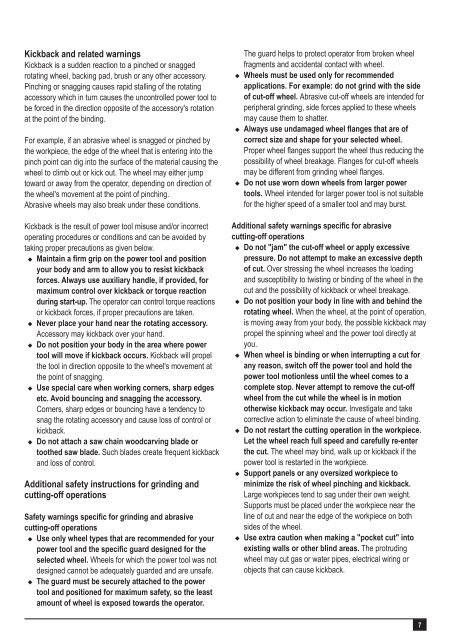BlackandDecker Smerigliatrice Angolare Piccola- Kg925 - Type 2 - Instruction Manual (Inglese)
BlackandDecker Smerigliatrice Angolare Piccola- Kg925 - Type 2 - Instruction Manual (Inglese)
BlackandDecker Smerigliatrice Angolare Piccola- Kg925 - Type 2 - Instruction Manual (Inglese)
You also want an ePaper? Increase the reach of your titles
YUMPU automatically turns print PDFs into web optimized ePapers that Google loves.
Kickback and related warnings<br />
Kickback is a sudden reaction to a pinched or snagged<br />
rotating wheel, backing pad, brush or any other accessory.<br />
Pinching or snagging causes rapid stalling of the rotating<br />
accessory which in turn causes the uncontrolled power tool to<br />
be forced in the direction opposite of the accessory's rotation<br />
at the point of the binding.<br />
For example, if an abrasive wheel is snagged or pinched by<br />
the workpiece, the edge of the wheel that is entering into the<br />
pinch point can dig into the surface of the material causing the<br />
wheel to climb out or kick out. The wheel may either jump<br />
toward or away from the operator, depending on direction of<br />
the wheel's movement at the point of pinching.<br />
Abrasive wheels may also break under these conditions.<br />
Kickback is the result of power tool misuse and/or incorrect<br />
operating procedures or conditions and can be avoided by<br />
taking proper precautions as given below.<br />
u Maintain a firm grip on the power tool and position<br />
your body and arm to allow you to resist kickback<br />
forces. Always use auxiliary handle, if provided, for<br />
maximum control over kickback or torque reaction<br />
during start-up. The operator can control torque reactions<br />
or kickback forces, if proper precautions are taken.<br />
u Never place your hand near the rotating accessory.<br />
Accessory may kickback over your hand.<br />
u Do not position your body in the area where power<br />
tool will move if kickback occurs. Kickback will propel<br />
the tool in direction opposite to the wheel's movement at<br />
the point of snagging.<br />
u Use special care when working corners, sharp edges<br />
etc. Avoid bouncing and snagging the accessory.<br />
Corners, sharp edges or bouncing have a tendency to<br />
snag the rotating accessory and cause loss of control or<br />
kickback.<br />
u Do not attach a saw chain woodcarving blade or<br />
toothed saw blade. Such blades create frequent kickback<br />
and loss of control.<br />
Additional safety instructions for grinding and<br />
cutting-off operations<br />
Safety warnings specific for grinding and abrasive<br />
cutting-off operations<br />
u Use only wheel types that are recommended for your<br />
power tool and the specific guard designed for the<br />
selected wheel. Wheels for which the power tool was not<br />
designed cannot be adequately guarded and are unsafe.<br />
u The guard must be securely attached to the power<br />
tool and positioned for maximum safety, so the least<br />
amount of wheel is exposed towards the operator.<br />
The guard helps to protect operator from broken wheel<br />
fragments and accidental contact with wheel.<br />
u Wheels must be used only for recommended<br />
applications. For example: do not grind with the side<br />
of cut-off wheel. Abrasive cut-off wheels are intended for<br />
peripheral grinding, side forces applied to these wheels<br />
may cause them to shatter.<br />
u Always use undamaged wheel flanges that are of<br />
correct size and shape for your selected wheel.<br />
Proper wheel flanges support the wheel thus reducing the<br />
possibility of wheel breakage. Flanges for cut-off wheels<br />
may be different from grinding wheel flanges.<br />
u Do not use worn down wheels from larger power<br />
tools. Wheel intended for larger power tool is not suitable<br />
for the higher speed of a smaller tool and may burst.<br />
Additional safety warnings specific for abrasive<br />
cutting-off operations<br />
u Do not "jam" the cut-off wheel or apply excessive<br />
pressure. Do not attempt to make an excessive depth<br />
of cut. Over stressing the wheel increases the loading<br />
and susceptibility to twisting or binding of the wheel in the<br />
cut and the possibility of kickback or wheel breakage.<br />
u Do not position your body in line with and behind the<br />
rotating wheel. When the wheel, at the point of operation,<br />
is moving away from your body, the possible kickback may<br />
propel the spinning wheel and the power tool directly at<br />
you.<br />
u When wheel is binding or when interrupting a cut for<br />
any reason, switch off the power tool and hold the<br />
power tool motionless until the wheel comes to a<br />
complete stop. Never attempt to remove the cut-off<br />
wheel from the cut while the wheel is in motion<br />
otherwise kickback may occur. Investigate and take<br />
corrective action to eliminate the cause of wheel binding.<br />
u Do not restart the cutting operation in the workpiece.<br />
Let the wheel reach full speed and carefully re-enter<br />
the cut. The wheel may bind, walk up or kickback if the<br />
power tool is restarted in the workpiece.<br />
u Support panels or any oversized workpiece to<br />
minimize the risk of wheel pinching and kickback.<br />
Large workpieces tend to sag under their own weight.<br />
Supports must be placed under the workpiece near the<br />
line of cut and near the edge of the workpiece on both<br />
sides of the wheel.<br />
u Use extra caution when making a "pocket cut" into<br />
existing walls or other blind areas. The protruding<br />
wheel may cut gas or water pipes, electrical wiring or<br />
objects that can cause kickback.<br />
7
















